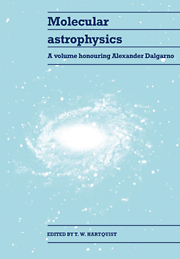Book contents
- Frontmatter
- Contents
- Dedication
- Preface
- Part I Molecular clouds and the distribution of molecules in the Milky Way and other galaxies
- Part II Diffuse molecular clouds
- Part III Quiescent dense clouds
- Part IV Studies of molecular processes
- Part V Atomic species in dense clouds
- 14 Observations of atomic species in dense clouds
- 15 Ultraviolet radiation in molecular clouds
- 16 Cosmic ray induced photodissociation and photoionization of interstellar molecules
- 17 Chemistry in the molecular cloud Barnard 5
- 18 Molecular cloud structure, motions, and evolution
- Part VI H2 in regions of massive star formation
- Part VII Molecules near stars and in stellar ejecta
- Part VIII Moderately ionized gas and chemistry at large redshifts
- Index
14 - Observations of atomic species in dense clouds
Published online by Cambridge University Press: 10 December 2009
- Frontmatter
- Contents
- Dedication
- Preface
- Part I Molecular clouds and the distribution of molecules in the Milky Way and other galaxies
- Part II Diffuse molecular clouds
- Part III Quiescent dense clouds
- Part IV Studies of molecular processes
- Part V Atomic species in dense clouds
- 14 Observations of atomic species in dense clouds
- 15 Ultraviolet radiation in molecular clouds
- 16 Cosmic ray induced photodissociation and photoionization of interstellar molecules
- 17 Chemistry in the molecular cloud Barnard 5
- 18 Molecular cloud structure, motions, and evolution
- Part VI H2 in regions of massive star formation
- Part VII Molecules near stars and in stellar ejecta
- Part VIII Moderately ionized gas and chemistry at large redshifts
- Index
Summary
Introduction
Over the past ten years, observations of the far-infrared and submillimeter fine structure emission from neutral oxygen and carbon, and singly ionized carbon and silicon, have revealed the presence of a dense (nH ≤ 103 cm−3), intermediate temperature (60 ≥ Tgas ≥ 1500 K) component of the interstellar medium in which a substantial fraction of the gas is atomic (see Table 14.1). In addition, observations of atomic fine structure emission from regions which are mostly molecular have helped to define the nature of the shocks which frequently accompany star formation and to challenge long-held beliefs about the structure and chemistry of molecular clouds.
Emission from atomic and ionic species with ionization potentials less than that of hydrogen arises predominantly in diffuse HI clouds, the photodissociated surfaces of molecular clouds, and the warm gas downstream of passing shock waves, generated deep within molecular clouds by the outflows from newly formed stars. The latter two regions, of primary interest in this contribution, are characterized by gas temperatures of 60–2000 K. Since H and He have no lowlying levels which can effectively cool the gas in this temperature range, the fine structure transitions of OI (63, 146 µm), C+ (158 µm), and Si+ (35 µm) generally dominate the cooling and thus serve as important diagnostics of these regions. An indication of the cooling power in just the [OI] 63 µm and [CII] 158 µm lines is given in Table 14.2; between 0.1 and 1% of the total luminosity of these sources escapes in these two lines.
- Type
- Chapter
- Information
- Molecular AstrophysicsA Volume Honouring Alexander Dalgarno, pp. 273 - 287Publisher: Cambridge University PressPrint publication year: 1990
- 2
- Cited by

